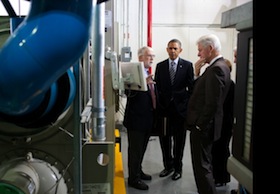President Announces $4 Billion Investment in Energy Upgrades
 WASHINGTON, D.C. — In a move that does not require congressional approval, President Barack Obama announced on Dec. 2 a nearly $4 billion commitment for energy upgrades to federal and private sector buildings over the next two years.
WASHINGTON, D.C. — In a move that does not require congressional approval, President Barack Obama announced on Dec. 2 a nearly $4 billion commitment for energy upgrades to federal and private sector buildings over the next two years.
The $4 billion investment includes a $2 billion commitment — made through presidential decree — to energy upgrades of federal buildings. Long-term energy savings will pay for the upfront cost, at no cost to taxpayers.
The remaining $2 billion will come from a commitment by 60 CEOs, mayors, university presidents and labor leaders to invest private capital into energy efficiency projects.
Last year, commercial buildings consumed roughly 20 percent of all the energy used by the U.S. economy.
“Upgrading the energy efficiency of America’s buildings is one of the fastest, easiest, and cheapest ways to save money, cut down on harmful pollution, and create good jobs right now. But we can’t wait for Congress to act,” the president said. “Coupled with today’s extraordinary private sector commitments of $2 billion to upgrade businesses, factories, and military housing, America is taking another big step towards the competitive, clean energy economy it will take to win the future.”
The announcement builds on a commitment made by 14 partners at the Clinton Global Initiative America meeting in June to make energy upgrades across 300 million square feet, and to invest $500 million in private sector financing in energy efficiency projects.
In a move the U.S. Chamber of Commerce recognized as critical to job creation, the Presidential Memorandum calls for the full implementation of existing federal authority to utilize the Energy Savings Performance Contracts program, where new energy-efficient equipment is installed at federal facilities at no up-front cost to the government and is paid for over time through lower utility bills, with private-sector contractors guaranteeing the energy savings.
President Obama and former President Bill Clinton made the commitments — part of the Better Buildings Challenge — in an announcement attended by representatives from more than 60 organizations.
The Challenge — a component of the Better Buildings Initiative launched in February by Obama — is spearheaded by former President Clinton and the President’s Council on Jobs and Competitiveness to support job creation by catalyzing private sector investment in commercial and industrial building energy upgrades.
The initiative aims to for at least 20 percent more efficiency by 2020 in 1.6 billion square feet of commercial, municipal, medical and education buildings to reduce energy costs for Americans by nearly $40 billion over the next decade.
Though the Better Buildings Initiative launched in February, little movement has occurred.
In a press conference after the announcement, President Obama said while the administration has asked Congress to approve more effective incentives for commercial building owners to move forward on energy-efficient steps, it can no longer wait for Congress to act.
“If they won’t act, I will,” he said.
Clinton said he was pleased the partnering programs were able to increase the initial $500 million Better Buildings Challenge commitment and 300 million square feet has grown to $2 billion for more than 1 billion square feet of retrofitted space.
“Investments in building retrofits and energy efficiency can make a real difference in the American economy, by creating jobs, growing our industries, improving businesses’ bottom lines, reducing our energy bills and consumption, and preserving our planet for future generations,” former President Clinton said. “I am proud the Clinton Foundation has been able to help develop and grow President Obama’s Better Buildings Challenge, and that so many members of the Clinton Global Initiative have joined this Challenge.”
AFL-CIO President Richard Trumka said the Better Buildings Initiative has “all the components to make a real difference.”
“It will create profitable investment opportunities for worker pension funds, create badly needed good jobs, increase America’s competitiveness around energy savings, and address the dangers of climate change," Trumka said.
